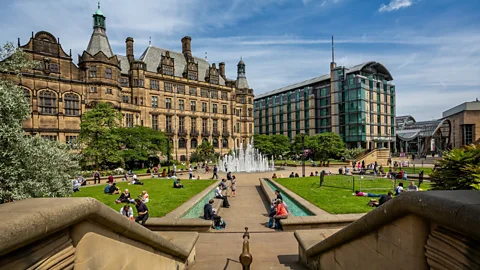ADS
Ancient candy-colored Venice, Italy, is one of the world’s most photographed and scenic cities. The gondolas drifting over its surreal canals draw millions of tourists each year, who crowd romantic bridges and gorgeous piazzas to grab that perfect image.
The SOS on the postcard is overtourism, which plagues this beautiful city. How can you have fun and take amazing images without upsetting the people or elbowing them?
SPECIALIST
Born and raised Venetian Stefano Mazzola was a restaurant owner before photography. International media including The Guardian, The New York Times, National Geographic, and Lonely Planet have published his non-touristy Venetian life photos.
We asked Venetian Getty photographer Stefano Mazzola for his distinct perspective. His advice: explore the famous sights at morning or dusk, when day trippers have left, and then appreciate Venice’s quirks. “Water is essential,” Mazzola remarked. The tide flows in for six hours, slacks for one hour, and then ebbs for six hours. Because of water and light, the city transforms every hour.”
Mazzola leads Venice photo tours to uncover the city’s most famous sights and oddities. “Yes, of course, go see the Basilica di San Marco, the Palazzo Ducale (Doge’s Palace), the prisons, Piazza San Marco,” said. Avoid spending 10 hours there. Explore. Walk. Get lost. Get lost with your companion or buddy. Stop for wine or cicchetto every hour and continue walking. That’s how you’ll find the best street corners, hidden jewels, and beauty.”
Venice’s six sestieri (districts) may be traversed by foot or canal aboard one of its vaporetti. Stefano Mazzola names Venice’s best picture spots.
1. Best dawn spot: Ponte dell’Accademia
Photographing Tips
Stefano Mazzola likes photographing images of Venice in all its moods, which are many due to its varying water levels and continual population. “Find a place, see if you like it,” says Mazzola. “Take the first shot without a subject to test the light and settings. Then wait. Maybe a gondola passes. A lovely yellow raincoat-wearing lady with a red umbrella may cross the bridge in two minutes. Maybe a guy with a beautiful dog will cross the bridge in five minutes. Every second at Piazza San Marco, you may shoot various individuals in different costumes.”
“There are two Venices,” Mazzola added. The popular Venice from Piazza San Marco to the Rialto Bridge is invaded from 9:00 to 06:00 or 07:00. I find it unlivable as a Venetian. Real Venice, the upper quarters, is still lovely.”
Beginning early is the secret to taking stunning shots in this touristy city without a head in the frame. Mazzola recommends Ponte dell’Accademia for dawn.
Mazzola says Venice’s four main bridges, including the massive wooden one spanning the Grand Canal, give a unique perspective as the sun shimmers over the rainbow-hued structures.
“If you’re on the Ponte dell’Accademia, looking towards the Grand Canal, Palazzo Cavalli-Franchetti is the first building on the left,” Mazzola. “You can take dawn photos of the Grand Canal, this wonderful edifice on the left, and the Basilica [of Santa Maria] della Salute on the right. I adore it.”
2. Best for seeing gondolas and gondoliers: Bacino di San Marco and Orseolo
In Italian, gondoliere/a is an iconic yet mythical person. Mazzola recommends returning before dawn to Bacino di San Marco, the city’s principal lagoon harbor, where gondolas park at night. “With the Palazzo Ducale behind you, you can shoot three, five, seven gondolas depending on how wide your lens is, with the Island of San Giorgio in the background,” Mazzola.
Mazzola enjoys visiting Bacino Orseolo to see the gondoliers in their natural condition. “It’s a minute away from Piazza San Marco,” stated. “Working gondolas park in the basin all night. At 7:30 or 8:00 in the morning, 30–35 gondolas are closed together. Cleaning crews remove tarps and clean gondolas individually. It’s particularly nice since the gondola cleaners converse in Venetian. The location welcomes. You see true Venice there.”
3. Best for Venice panorama: Scala Contarini del Bovolo
VENICE CARNEVALE
Venice is so gorgeous you’ll want to see it all. Mazzola’s favorite spot for a jaw-dropping city view is the Scala Contarini del Bovolo, an 80-step spiral staircase in a tower at Palazzo Contarini.
Venice’s splendor and picture opportunities are even better in the weeks leading up to its world-famous masked Carnevale festivities, when individuals don elaborate maschere. “It’s very nice to see the maschere inside the historic Caffé Florian,” Mazzola remarked of the 1720 Piazza San Marco café. “During the last two weeks of Carnevale, before sunset, the people in costume go to the Island of San Giorgio and pose for the photographers with Piazza San Marco and the Palazzo Ducale behind them,” Mazzola stated. “The light of the sunset softly colours everything.”
But Carnevale makes the already-bursting-at-the-seams city even more hectic, so how can you snap amazing shots among a sea of masked tourists? “When people are around, it’s complicated,” Mazzola said. “The only way is to photograph half-length from below with a beautiful building in the background.” Do not visit Venice the weekend before Fat Tuesday, Mazzola said. “Come to Venice during the other Carnival days.”
Bovolo means spiral in Venetian, Mazzola said. The palace is located midway between Piazza San Marco and Rialto Bridge. this amazing spiral staircase makes it distinctive. You climb all these steps to the palace’s spectacular patio with 360-degree round arches. See all of Venice.”
The aristocratic Contarini family erected the Venetian Gothic Palazzo Contarini del Bovolo in a secluded side lane near Campo Manin in the 15th century. “It’s amazing for taking photos because you can take a shot of two arches with a slice of San Marco inside,” Mazzola. Or two more arches that catch the Basilica dei Frari, offering a panoramic view of Venice. Beautiful hidden jewel.”

4. Santa Croce and San Polo Sestieri are best for concealed passageways.
Venetian beauty is in the details. When visitors crowd the city center, Mazzola proposes crossing the Rialto Bridge to see San Polo and Santa Croce.
Mazzola: “They’re full of little labyrinths.” “This neighborhood is formed of small, narrow streets in Venice, where calle means street. I can tour for two hours, but we never get far. Never see the same spot again!”
The surrounding Sestieri di San Polo e Santa Croce have medieval architecture and bustling fish, meat, and green markets but are seldom visited by visitors. “It’s lovely because every two minutes you find this beautiful corner, this beautiful reflection or some crooked bridge, as gondolas are passing,” Mazzola. “Campo San Boldo is a great plaza between San Polo and Santa Croce. Numerous artworks and films have explored this topic. A well is in the center. A belltower is losing its tip. The canal goes beside the twisted Ponte Storto bridge. really pretty. Rarely anybody visits.”
5. Corte Nuova shows Venetian life well.
Venetians think of laundry drying in the sun, while tourists think of gondoliers kayaking around canals. “It’s prohibited to hang your laundry out to dry in Venice in the [heavily touristed] sestiere of San Marco,” Mazzola. You must keep laundry inside. But not in other districts. Corte Nuova in Castello is great because folks put out their clothes to dry every morning when it’s sunny. The street becomes colorful.”
Line drying laundry is one of the most Italian practices, even in lovely Venice, where you’ll smell Marseille soap as you walk past the calle. Many Italian towns forbid it in tourists areas. “It’s great to see sheets, clothes, laundry, and washing. Mazzola called it renowned. Because of its Venetian population, Castello is a daily part of life. San Marco doesn’t have Venetian speakers. German, English, Russian, Chinese. Venetian is heard in Castello.”
6. Best sunset spot: Arsenale di Venezia
Venice’s greatest dawn spot is a Grand Canal bridge, while the Arsenale di Venezia, the city’s military zone, has great sunsets. “That’s also in Castello,” Mazzola replied. “The Arsenale, Venice’s military location where battleships were built, has tight walls. The Arsenale now houses the military marina.”
Mazzola describes why a military zone at dusk may look unromantic: “The sun sets behind San Marco. You go to capture the final sun with the tower in Piazza San Marco. The Grand Canal begins, Piazza San Marco is on the right, and all the water is visible. The sunset follows.
7. Best Classic Venice Photo: Rialto Bridge
Few Venice sights are as memorable as the Rialto Bridge, with its high roof and beautiful arches sweeping across the Grand Canal. The existing stone bridge, rebuilt multiple times since the 12th century, has been a part of Venetian life since the late 1600s and a draw for visitors since.
“If you go at 07:00 in the morning, you’ll just find two people so you can take photos and it’s nice,” Mazzola. “But if you go at noon or at [15:00] in the afternoon, you’ll find 200 people taking selfies and in my opinion it’s no longer enjoyable.” Wishful: “All locations are great. Visitors must attend at particular times of day to enjoy them.”





